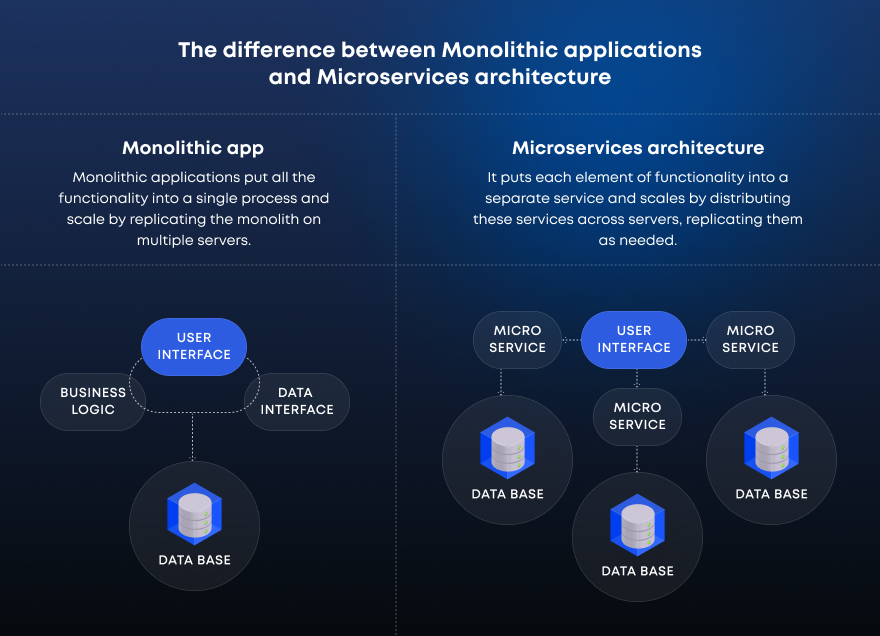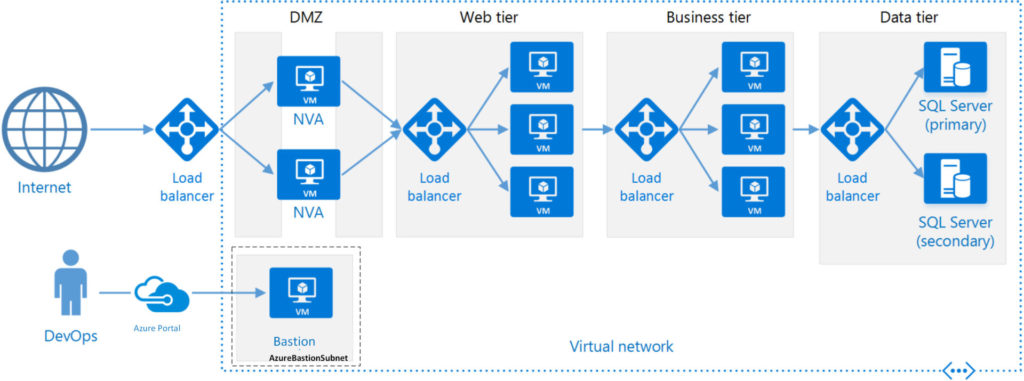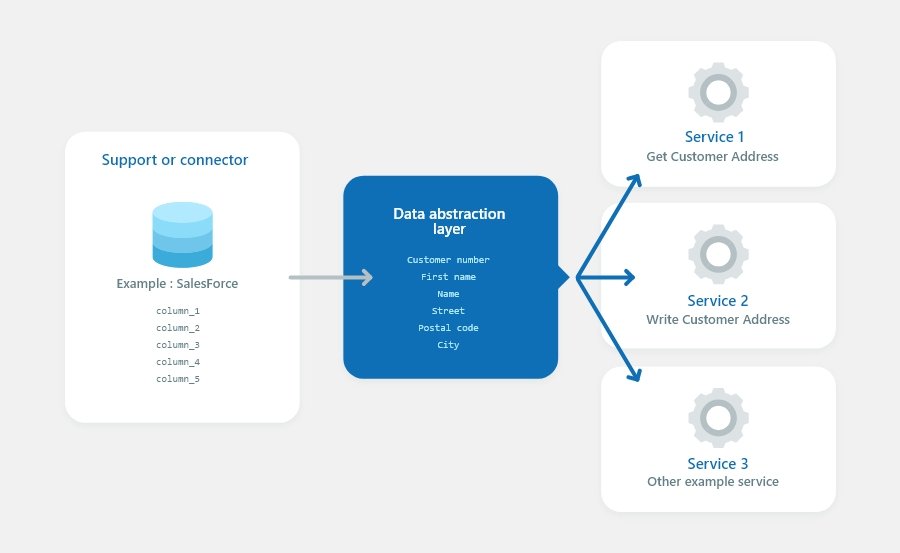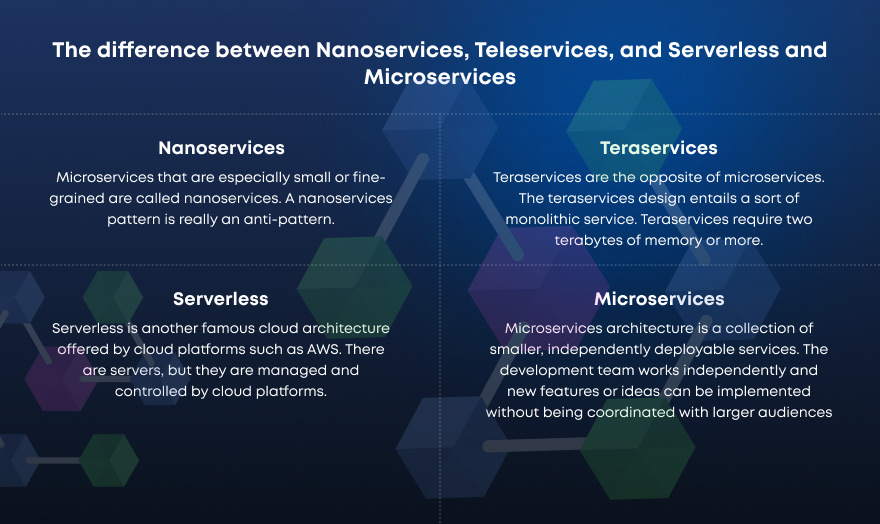The choice of architecture is one of the crucial steps for a software developer to start a new project. It influences the project flow and the way you will tackle changing application needs in the future, etc.
Messy and bad project architecture often leads to messy code, difficult maintenance, and complex implementation of new features. In this article, we will cover the main reasons why most developers prefer Node.Js to build microservices apps and discuss some major nuances of microservice architecture.
Is Microservices architecture only a buzzword in the tech space?
The process of designing an application is not just about providing a solution. As a result of the vast system’s size, the developers face various challenges including ensuring that the codebase is maintained, adding features, bug fixes, and controlling user roles. At scale the considerations are nontrivial, so developers have to employ several techniques to avoid it.
Over the last time, microservices architecture is among the most debated topic. Back in the dawn of software engineering microservices architecture did not even exist. All apps were monolithic. A team of developers built a program, implemented all the functionality, and deployed the monolithic applications.

Later, developers started to modularize things, which enabled them to write a module and link it to other modules, thus forming a software package with reusable components. You reduce risks and gain a specific level of independence since modules are independently deployable and can be updated separately. It led to the emergence of n-tier architecture.

Developers noticed that tiers can communicate with each other directly, which speeds up the development process and allows working on them separately. It is called Service Oriented Architecture – SOA. And microservice architecture belongs to it since consists of different services communicating with each other.

Nowadays, a predominant number of companies prefer using monolithic application architecture, however, such market leaders as Netflix, Uber, Amazon, and Soundcloud have successfully adopted the microservices architecture. Such apps are scalable, are easier to maintain and upgrade, offer better developer experience, and have an extensive knowledge base.
Microservices architecture alternatives
Also exists some SOA alternatives, however, some of those are too immature or are used only for specific business needs.

Microservice architecture puts every app feature in its own service, which simplifies the deployment. In monolithic architecture, updating the codebase affects the whole system, and the smallest code changes require building and deploying a new version of the whole software. Microservice resolves the above-mentioned challenges and fragments the system into smaller chunks.
Real benefits of using the microservice architecture
- This architecture is not limited by the usage of a specific programming language, it allows building the app with any language supporting the chosen communication protocol;
- It allows easier maintenance of the app, and features can be split among the big team of developers, who can introduce changes independently;
- Iterating is much easier and components do not influence each other.
Understanding the tech side of microservices
Microservices architectures represent an evolution in service-oriented architectures in which an app is arranged by a set of independently interconnecting services which connect via different networks such as HTTP.
Many applications that provide web-based services based on REST / Graph QL interfaces now utilize microservices. Here are some main aspects to consider, that will provide you a better understanding of dealing with the microservices architecture.
Environment variable
When building microservices with Node.Js, you need to create a clean environment following the set of baseline requirements. You should have the team members responsible for the macro-architecture. They will define the infrastructure for the development and operation of microservices. Each app will have its unique macro-architecture.
The documentation of macro-architecture should be open for change, to enable the team to adapt it to the arising needs.
CI/CD
One of the core specificities of microservices architecture is that testing is performed at a high speed. Every commit in microservices should result in a tested build. After the test pass, the next important step is automatic deployment to production.
An organization should strive to achieve continuous development and integration, and overall consistency of services. Cutting the deployment time allows rapid iteration.
Containers and Virtual machines
To be able to spin up the number of instances of a specific service, macro architecture needs to consider how multiple teams will manage to deal with development, testing, staging and production environment variables.
Staging and production are often done following the canary roll-outs strategy, allowing to roll back in case of failures. The establishment of the common infrastructure, policies, and procedures around packaging and deployment of your service will simplify the development and operations.
Load monitoring and instance control management are also facilitated by this area of macro-architecture.
Logging
Monitoring the microservices in production is also essential. You need to enable the quick location of disparate information. Thus, your macro-architecture needs to consider the following aspects:
- Logging service for centralized logging;
- Definition of trace IDs;
- Basic format requirements for trace ID, timestamp, server, service, instance, etc.
Communication between microservices with Node.Js
Communication between the microservices is a crucial aspect you should pay attention to. Services are closely coupled, and together they contribute to the smooth performance of the app. To secure the best performance of the app built with microservices architecture, it is necessary to configure smooth communication between microservices.
Communication within microservices is possible thanks to inter-service communication protocols like HTTP(s), gRPC, or message brokers.
HTTP is a synchronous communication pattern where services are interdependent to perform.
As a rule, microservices architecture relies on event-driven architecture communication. It uses events to communicate between the decoupled server-side applications and entails interaction between the service provider and the consumer.
Why does Node.Js use the Microservices approach?
You can choose any programming language to build a microservices architecture app, however, Node.Js has proved to be the best possible option.
The relationship between Node.Js and microservices architecture is extremely strong since Node was created to support the easier building of microservices apps. Node.Js is fast during the execution, uses an event-driven loop, uses an asynchronous nature event loop, and is highly scalable.
Node.Js benefits
As is often the case, Node.Js is the best choice when you decide to build the app using the microservices approach. There are several reasons for it:
- Node.Js uses the event loop to execute the code, and even asynchronous code can be executed;
- Node.Js uses architectures that are event-driven and allow using the common pattern in software development – observer pattern, allowing to build of powerful real-time apps;
- JavaScript engine ensures that the code will be executed quickly and allows handling a huge number of requests;
- Responsibility for specific operations is assigned to separate parts of the app, and these components can be modified and deployed and independent;
- Solutions built with microservices can be tested in production, by implementing them in restricted segments of users and testing the app with real users;
- It shortens the release cycles and considerably cuts the app build. Time
Compared to JavaScript application programming, .NET, and Python programming, Node.Js code is simple to set up and maintain. You do not need to do complex setups, allows quick external API implementation and development.
Building JavaScript Microservices with Node.js: Best practices
Building an app is not an easy task, since you face the challenge to maintain the code, debugging, and upgrading the app with the new features. Apps that are built with numerous services, modules, and packages.
Microservices architecture presupposes breaking the big monolithic app into small independent chunks making an app a collection of loosely coupled services.
Node.Js specificities
NodeJS’s database contains numerous JavaScript Modules which simplify applications on a very large scale. Software architects preferred Nodes.Js technology partners for the development of JSON API-enabled applications i.e. I/O-binding applications, data stream applications, web applications & real-time applications.
Node.Js provides a variety of useful applications that are actively used in enterprise applications like Microsoft, PayPal, Uber, etc.
To build the advanced Node.Js app by following the microservices app, it is necessary to consider some major specificities:
- The Microservices approach presupposes dealing with multiple components of the app. Software is built on separate components, each service can be easily modified;
- The Microservice approach presupposes relies on business functions and precedence. Teams are assigned to separate business capabilities, which acts as a separate project;
- Microservices operate on different platforms and services supporting decentralized data management. Separate services manage separate databases, which align with decentralized governance;
- Microservices architecture is fault-resistant since it relies on real-time service monitoring. Since services are separated you can quickly spot the failed service.
Our team will help to successfully move your monolithic app to microservices architecture!
Best practices to build microservices with Node.Js
- Examine your business needs and dedicate time to planning and organizing. Examine your needs and divide them into app functions. If you are in the process of transitioning from a monolithic app to microservices architecture, get every member of a team and conduct detailed onboarding.
- Dedicate enough time and effort to split your business functions and services, to create the needed combination of individual services.
- Use event loops and third-party API to communicate between services, instead of calling each service separately
- Despite the fact, that microservice architecture allows the implementation of multiple services combined in one app, each service should have its version and control strategy, and separate repository.
- The development environment of each service should be a virtual machine. It enables developers to adjust the framework and start coding, taking care of all the necessary software components.
- The implementation of API calls as a response to each user query allows for backward comparability. You can build production-ready apps more quickly.
- Each service should have its storage or database. This database should meet the production requirements, and adapt architecture and storage to the type of data it will contain.
- Containerize your services by making a separate build, which will automate the deployment process.
Why microservices and Node.Js complement each other ?
If we dig deeper and analyze why microservices and Node.Js go hand in hand, we will come to some logical conclusions. Primarily, both of them have the same underlying approach and runtime environment. Moreover, Node.Js allows for building microservices with a variety of methods.
Building microservices is a complex approach, and you have to deal with orchestration, inner-service communication, cluster management, etc. to build a scalable microservices app.
Our Altamira development team has over a decade of experience in building efficient Node.Js apps. We offer scalable and real-time solutions based on your current business needs.
Node.Js powers quick REST APO development and integration, utilizing the best security approaches. You can benefit from all the possibilities Node.Js offer by supplementing your existing team with our developers. Faster, cheaper, and more efficient development is guaranteed.
To sum up
Microservice architecture is one of the best options nowadays. However, exist also some alternatives, which solve the problems and drawbacks of monolithic systems architecture and allow to speed up deployment, and deal with the new challenges of cloud-based and distributed apps.
When it comes to choosing the best option, for sure microservices have been around longer, have a wide community, and have a clear advantage.
Exists a big number of resources, and microservices can work with a great number of technologies, including Node.Js. Using JavaScript presupposes dynamic programming. You can introduce new features, and simultaneously you need to monitor and fix issues, keeping the code clear.
FAQ
Using microservices gives the desired level of flexibility and great app performance, which cannot be achieved when building monolithic applications. Even-driven architecture makes Node.Js the perfect pair for microservices.
Since Node.Js uses event-driven architecture, enabling real-time app development it will become the optimal choice to build a microservices application. The development team will be able to benefit from the speed, scalability and easy maintenance, and uninterrupted development flow.






